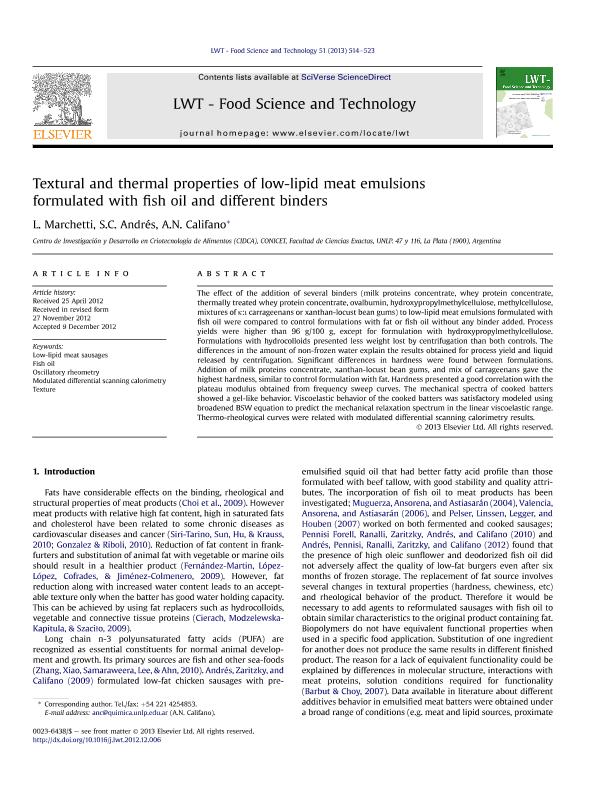Artículo
Textural and thermal properties of low-lipid meat emulsions formulated with fish oil and different binders
Fecha de publicación:
05/2013
Editorial:
Elsevier Science
Revista:
LWT - Food Science and Technology
ISSN:
0023-6438
Idioma:
Inglés
Tipo de recurso:
Artículo publicado
Clasificación temática:
Resumen
The effect of the addition of several binders (milk proteins concentrate, whey protein concentrate, thermally treated whey protein concentrate, ovalbumin, hydroxypropylmethylcellulose, methylcellulose, mixtures of k:i carrageenans or xanthan-locust bean gums) to low-lipid meat emulsions formulated with fish oil were compared to control formulations with fat or fish oil without any binder added. Process yields were higher than 96 g/100 g, except for formulation with hydroxypropylmethylcellulose. Formulations with hydrocolloids presented less weight lost by centrifugation than both controls. The differences in the amount of non-frozen water explain the results obtained for process yield and liquid released by centrifugation. Significant differences in hardness were found between formulations. Addition of milk proteins concentrate, xanthan-locust bean gums, and mix of carrageenans gave the highest hardness, similar to control formulation with fat. Hardness presented a good correlation with the plateau modulus obtained from frequency sweep curves. The mechanical spectra of cooked batters showed a gel-like behavior. Viscoelastic behavior of the cooked batters was satisfactory modeled using broadened BSW equation to predict the mechanical relaxation spectrum in the linear viscoelastic range. Thermo-rheological curves were related with modulated differential scanning calorimetry results.
Archivos asociados
Licencia
Identificadores
Colecciones
Articulos(CIDCA)
Articulos de CENTRO DE INV EN CRIOTECNOLOGIA DE ALIMENTOS (I)
Articulos de CENTRO DE INV EN CRIOTECNOLOGIA DE ALIMENTOS (I)
Citación
Marchetti, Lucas; Andres, Silvina Cecilia; Califano, Alicia Noemi; Textural and thermal properties of low-lipid meat emulsions formulated with fish oil and different binders; Elsevier Science; LWT - Food Science and Technology; 51; 5-2013; 514-523
Compartir
Altmétricas




